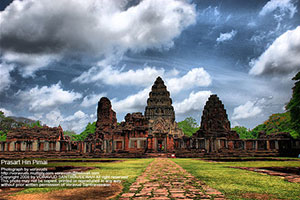Phimai Historical Park

Rating: 4.2/5 (6 votes)
Nakhon Ratchasima attractions
Attractions in Thailand
Operating day: Daily
Operating time: 07.30 - 18.00
Phimai Historical Park Within the Park is the Phimai Sanctuary, one of the grandest and most important Khmer historical sites in Thailand.
The word Phimai appears in an inscription on a stone slab at the front doorway of the building as well as in many other structures. It is believed that the word Phimai referred to a religious figure or site.
The Phimai Sanctuary is rectangular in shape and is 565 meters wide and 1,030 meters long. It consists of ornately carved sandstone and laterite structures. The most special characteristic of the sanctuary is that it is the only one that faces south while the others usually face east. This is probably because it was built to face the route that the Khmers traveled from the capital of the empire, to the south of Phimai.
From stone inscriptions and the architectural style, the Phimai Sanctuary was most likely built at the end of the 11th century during the reign of King Suriyaworaman I. The architectural style is that of the Baphuon style that prospered at the time. However, some characteristics are similar to that of Angkor Wat, which became popular at a later period. Some additions were made to the site in the early 18th Buddhist century during the reign of King Chaiworaman VII when Phimai had close relations with the Khmer Empire.
The sanctuary was always a religious site of the Mahayana sect of Buddhism because King Suriyaworaman I and King Chaiworaman VII were followers of the sect. Important Structures in Phimai Sanctuary:
The Naga Bridge is the first part you pass when visiting the site. The bridge and lion figures stand in front of the Gopura (porch) south of the main pagoda. The intention may have been to build a link between earth and heaven according to both Hindu and Buddhist beliefs concerning the universe.
The Gopura was adapted as the wall around the sanctuary and the four entering porches. There is a large corridor connecting the outer and inner areas of the main sanctuary. Above each porch is a lintel of various designs.
The Main Prang or pagoda is on an open area in a curved walkway. It is the centre of the site and is made entirely of white sandstone and is different from the porches and walls that are made primarily of red sandstone. This is because white sandstone is more durable than red sandstone. The pagoda is 28 meters high, has a square base, a portico and stairways and doors in all 4 directions.
The pagoda consists of a base, outer walls, columns, and porches with beautiful designs. Of vital importance are the lintels that mostly recount the tale of Ramayana from Hinduism and tales of the Mahayana sect of Buddhism. The lintels above the 4 doorways of the main pagodas inner chamber, the most important room of the pagoda, are all about Buddhism reflecting the Buddhist influence that eventually surpassed that of Hinduism. The carvings are of the Baphoun style and the Angkor Wat style leading to the belief that the main pagoda was built at the end of the 12th century.
here are other pagodas, which are Prang Brahmadat in front of the main pagoda, Prang Hin Daeng and Ho Phram (Brahma Hall) to the right.
The park is open daily from 7.30 a.m. to 6 p.m. The admission is 40 baht. There are youth guides available to provide visitors with information about the site for free. Historical Sites Outside Phimai Sanctuary:
The Phimai City Gate and City Walls were built during the reign of King Chaiworaman VII. Of the 4 gates, the south gate is the most important because the road from the ancient Khmer capital to Phimai runs through it. The sanctuary can be seen when looking straight through the gate.
The Men Brahmadat is southeast of the walls and is made entirely of bricks. Its present form is a huge and round earth hill that is about 30 meters high. The site is believed to have been the place where a king was cremated. However, the style of construction suggests it was built in the late Ayutthaya period.
Other sites to the south are Tha Nang Sa Phom, Kuti Rusi and Arokhayasan.
Phimai National Museum The museum houses collections of archaeological artifacts especially those found in the lower part of the region and has exhibits on the past cultural prosperity of the Northeast. There are several sections as follows:
Local Northeastern culture Daily utensils like mortars, cotton chests, carts and monk items lintels from sanctuaries in Nakhon Ratchasima and the Northeast prehistoric artifacts such as ancient pottery, skeletons, tools, and bronze and stone ornaments.
The history of Phimai Early history that includes Dvaravati-style temple boundary markers and Khmer-style items like columns and parts of buildings, as well as sculptures like Buddha images, god figures and a figure of King Chaiworaman VII made of sandstone found at Phrommathat Pagoda in Phimai sanctuary.
The second floor is devoted to the past cultural glory of the Northeast, early Northeastern communities and Khmer cultural influence.
The Museum is located at the base of Tha Songkran Bridge just before Phimai Sanctuary. From Nakhon Ratchasima, take Highway No. 2 for 50 kilometers, then turn on Highway No. 206 and proceed for 10 kilometers. If taking a bus from Nakhon Ratchasima, visitors can take a bus from Bus Terminal 2 in the city. The museum is open from Wednesday - Sunday during 9 a.m.-4 p.m. The entry fee is 30 baht. For information, call 0 4447 1167.
Sai Ngam Sai Ngam is on the bank of the Mun River near Phimai Dam. Cross Tha Songkran Bridge into the town and take a branch road to the dam for 2 kilometres. The place is so named because of the abundance of banyan trees here, all originating from a single tree, which is about 350 years now. The tree gave birth to many smaller ones covering the entire area. Nearby are souvenir shops and several restaurants. The most popular dish for tourists is Phimai noodles.
Thung Samrit Memorial This wide field was a battleground between Khorat people and Lao soldiers during the reign of King Rama III. A shrine was constructed by villagers in 1988 to pay homage to the fighters. The memorial is located at Moo 1, Ban Samrit Tawan Ok, Tambon Samrit, 46 kilometers from the city.
Take Highway No. 2 (Nakhon Ratchasima-Khon Kaen) to the 43-44 kilometer markers (opposite the entrance to Ban Prasat), turn right and proceed for about 3 kilometers.
How to get there
By Car From Nakhon Ratchasima, take Highway No. 2 for 50 kilometers, then turn on Highway No. 206 and proceed for 10 kilometers.
By Bus Taking a bus from Nakhon Ratchasima, visitors can take a bus from Bus Terminal 2 in the city.



 Category:
Category:  Group:
Group: